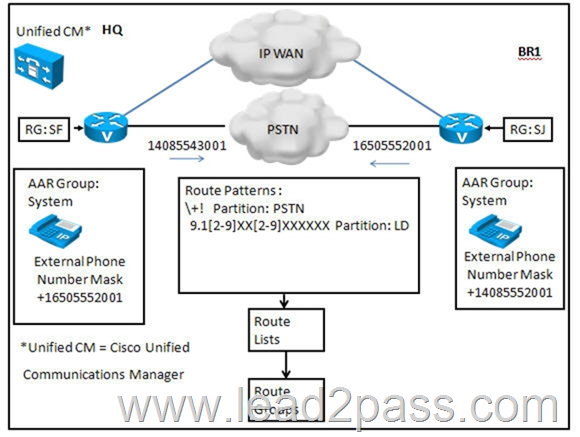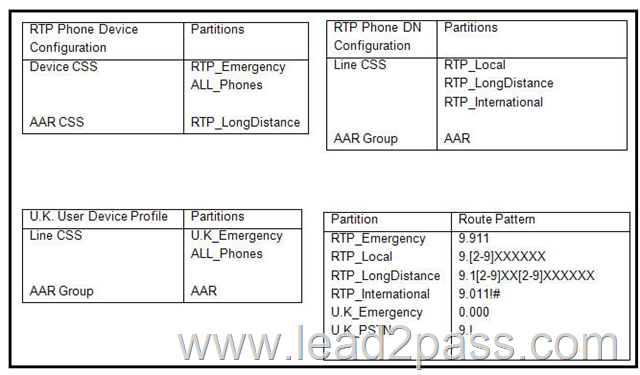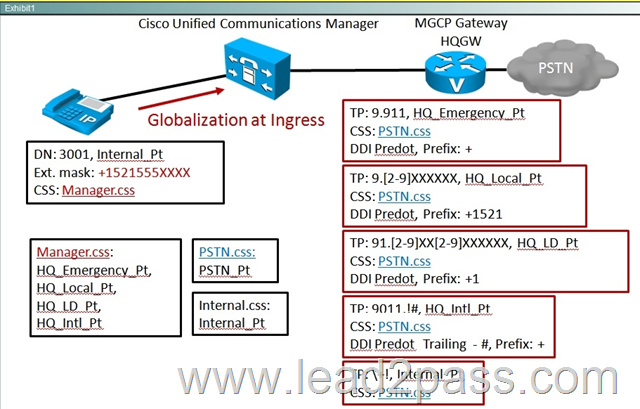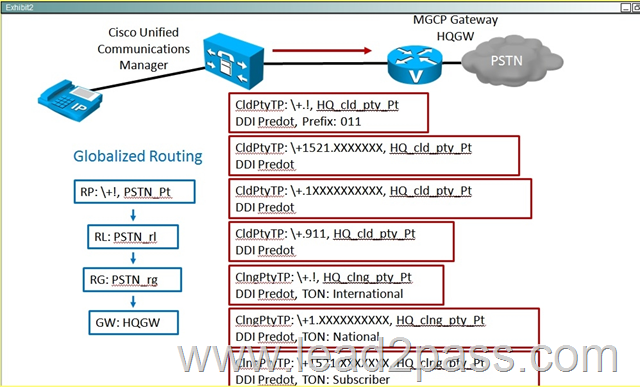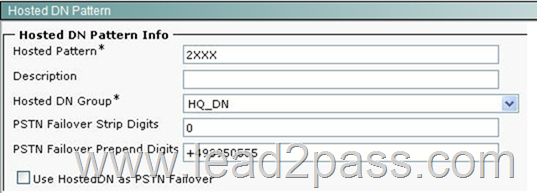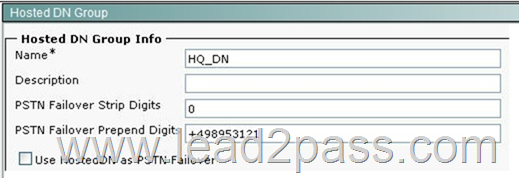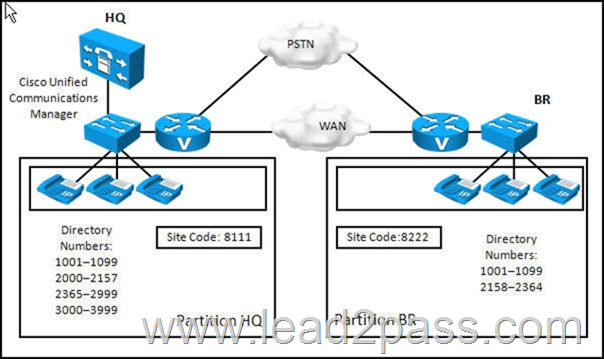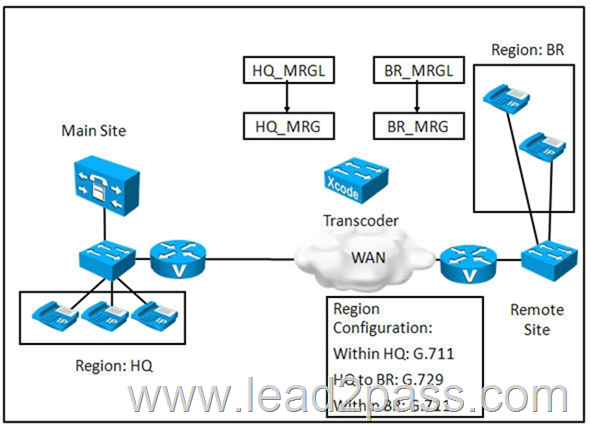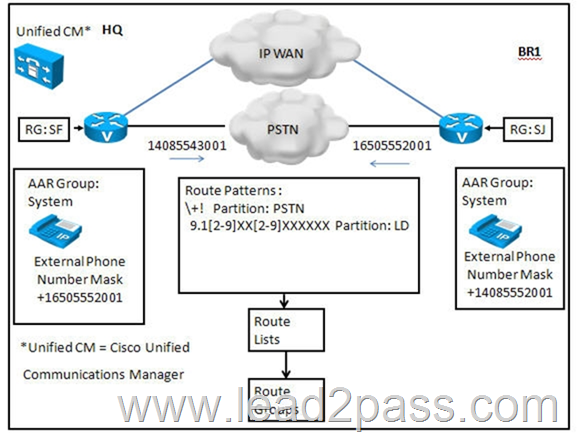2016 November Cisco Official New Released 300-075 Dumps in Lead2pass.com!
100% Free Download! 100% Pass Guaranteed!
There is no need to hassle if you are stuck in the 300-075 exam difficulties, Lead2pass will assist you right through 300-075 exam with 300-075 PDF and VCE dumps. Lead2pass delivers the most comprehensive 300-075 exam preparation material, covering each and every aspect of 300-075 exam curriculum. We ensure you 100% success in 300-075 exam.
Following questions and answers are all new published by Cisco Official Exam Center: http://www.lead2pass.com/300-075.html
QUESTION 201
Refer to the exhibit. The HQ site uses area code 650. The BR1 site uses area code 408. The long distance national code for PSTN dialing is 1. To make a long distance national call, an HQ or BR1 user dials access code 9, followed by 1, and then the 10-digit number.
Both sites use MGCP gateways. AAR must use globalized call routing using a single route pattern. Assume that all outgoing PSTN numbers are localized at the egress gateway as shown in the exhibit.
Which partition should be configured in the AAR CSS applied at the phones?
A. PSTN partition
B. LD partition
C. The HQ AAR CSS must include a partition assigned to route pattern 91408XXXXXXX. The BR1 AAR CSS must include a partition assigned to route pattern 91650XXXXXXX.
D. AAR CSS must contain translation pattern 9.1[2-9]XX[2-9]XXXXXX for each site that must be globalized. Otherwise the called numbers will not be localized at the egress gateway.
Answer: A
QUESTION 202
Refer to the exhibit. The HQ site uses area code 650. The BR1 site uses area code 408. The long distance national code for PSTN dialing is 1. To make a long distance national call, an HQ or BR1 user dials access code 9, followed by 1, and then the 10-digit number.
Both sites use MGCP gateways. AAR must use globalized call routing using a single route pattern. Assume that all outgoing PSTN numbers are localized at the egress gateway as shown in the exhibit.
How many route lists and route groups should be configured for AAR at a minimum?
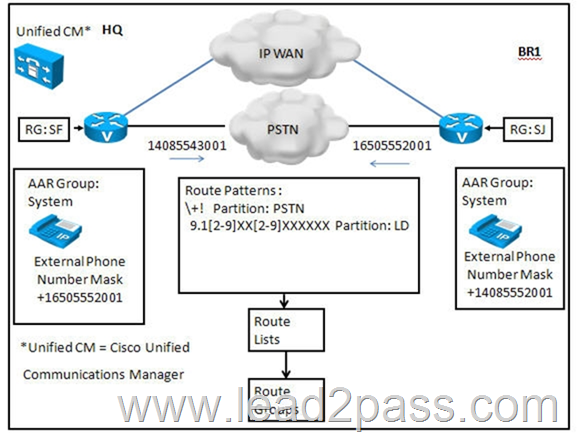
A. a single route list with a local route group for each site
B. two route lists and two route groups for each site
C. a single route list and four route groups for each sitea
D. None. The AAR CSS can point directly to the route pattern.
Answer: A
QUESTION 203
Assume a centralized Cisco Unified Communications deployment with the headquarters in the U.K, and remote site in RTP. All route patterns are assigned a route list that points to the local route group. Local route groups have been configured on the U.K and RTP device pools. A U.K. user logs onto an RTP phone using the Cisco Extension Mobility feature and places an emergency call to 0000. Which statement about the emergency call is true?
A. The call will match the U.K_Emergency route pattern partition and will egress at the RTP gateway.
B. The call will match the U.K_Emergency route pattern partition and will egress at the U.K.
gateway.
C. The call will match the RTP_Emergency route pattern partition and will egress at the U.K.
gateway.
D. The call will match the RTP_Emergency route pattern partition and will egress at the RTP gateway.
E. The call will fail.
Answer: A
QUESTION 204
Refer to the following exhibit. The MGCP gateway has the following configurations:
called party transformation CSS HQ_cld_pty CSS (partition=HQ cld_pty.Pt) call.ng party transformation CSS HQ_clng_pty CSS (partition=HQ_clng_pty Pt)
All translation patterns have the check box “Use Calling Party’s External Phone Number Mask” enabled.
When the IP phone at extension 3001 places a call to 9011 49403021 56001# what is the resulting called and calling number that is sent to the PSTN?
A. The called number is 01 1 49403021 56001.
The calling number will be 5553001 and number type set to subscriber.
B. The called number is 011 49403021 56001.
The calling number will be 5215553001 and number type set to national.
C. The called number is 4940302156001 with number type set to international.
The calling number will be 5215553001 and number type set to national.
D. The called number is +49403021 56001 with number type set to international.
The calling number will be 5215553001 and number type set to subscriber.
Answer: A
Explanation:
Check the check box “Use Calling Party’s External Phone Number Mask” if you want the full, external phone number to be used for calling line identification (CLID) on outgoing calls. You may also configure an External Phone Number Mask on all phone devices.
QUESTION 205
Refer to the exhibit When the Cisco Unified Communications Manager advertises the Hosted DN Pattern, which pattern would be advertised?
A. 2XXX and the T0D1D will be 0:+498950555
B. 2XXX and the ToDID will be 0:+4989531 21
C. 4989S05552XXX and the ToDiD will be 0:
D. + 4989631 21 2XXX and the ToDiD will be 0:
E. Both +4989505552XXXand +4989531 21 2XXX will be advertised with ToDID of 0:
Answer: A
QUESTION 206
When an external call is placed from Ajax, they would like the ANI that is sent to the PSTN to be the main number, not the extension. For domestic calls, they would like 10 digits sent; for international calls, they would like to send the country code 1 and the 10 digits. How can this be accomplished?
A. Add a translation pattern to the dial peers in the gateway that adds the appropriate digits to the outgoing ANI.
B. In the external call route patterns, set the external phone number mask to the main number.
Use 10 digits in the domestic route pattern and 1 followed by the main number digits in the international route patterns.
C. Use a calling party transform mask for each route group in the corresponding route list configuration. Set the explicit 10-digit main number for domestic calls and 1 followed by the main number for the international route patterns.
D. In the directory number configurations, set the prefix digits field to the country code and the 10 digits of the main number. This will be truncated to the 10-digit number for domestic calls and sent out in its entirety for international calls.
Answer: C
Explanation:
calling party transformation mask value is Valid entries for the NANP include the digits 0 through 9; the wildcard characters X, asterisk (*), and octothorpe (#); and the international escape character +.
QUESTION 207
Which trunk should you use in an H.323 gatekeeper-controlled network?
A. H.323
B. H.225
C. SIP
D. Intercluster
E. MGCP FXO trunk
F. MGCP T1/E1 trunk
Answer: B
QUESTION 208
Which E.164 transformation pattern represents phone numbers in Germany?
A. \+49.!
B. 49.!
C. \49.!
D. \+49.X
Answer: A
QUESTION 209
Which two statements are true regarding the implementation of globalized call-routing in terms of localized call egress? (Choose two.)
A. Calling-party numbers are routed from the gateway or trunks to phones.
B. Called-party numbers are routed from the gateway or trunks to phones.
C. Calling-party numbers of internal calls are routed from the gateway or trunks.
D. Calling-party calls are routed to the gateway and trunks.
Answer: AD
QUESTION 210
Refer to the exhibit. Assume that the HQ phones have access to the HQ partition, and BR phones have access to the BR partition. Which set of implementations would best address the overlapping directory number extensions for intersite (WAN) calling between the HQ site and the BR site?
A. Configure a route pattern 8222.[12]XXX for site HQ, and assign it to partition HQ. Configure the called party DDI of Predot.
Configure a route pattern for site BR 8111.[1-3]XXX, and assign it to partition BR. Configure called party DDI Predot.
Use the local gateway at each site. Prefix the appropriate site code for the calling number.
B. Configure a single route pattern for both sites 8[12,12,12].[1-32]XXX. Use a route list that contains the local route group for each site. Prefix the appropriate site code for the calling number.
C. Configure a translation pattern 8222.[12]XXX for site HQ, and assign it to partition HQ.
Use a CSS that contains the partitions for BR phones.
Configure a translation pattern 8111.[1-3]XXX for site BR, and assign it to partition BR.
Use a CSS that contains the partitions for HQ phones.
For both translation patterns, configure the called party DDI of Predot.
Prefix the appropriate site code for the calling number.
D. Configure a translation pattern 8222.[12]XXX for site HQ, and assign it to partition BR.
Use a CSS that contains the partitions for HQ phones.
Configure a translation pattern 8111.[1-3]XXX for site BR, and assign it to partition HQ. Use a CSS that contains the partitions for BR phones.
For both translation patterns, configure the called party DDI of Predot.
Prefix the appropriate site code for the calling number.
Answer: C
QUESTION 211
What is the difference between an H.323 gateway and a SIP gateway?
A. An H.323 gateway requires that dial peers be configured before PSTN calls can be placed and received.
The SIP gateway requires no dial peers.
B. The H.323 gateway can be added in Cisco Unified Communications Manager under gateway type as H.323 Gateway.
The SIP gateway can connect to Cisco Unified Communications Manager only through a SIP trunk.
C. A SIP gateway requires a call agent for PSTN calls to be placed and received.
An H.323 gateway does not require a call agent for PSTN calls to be placed and received.
D. An H.323 gateway can register with Cisco Unified Communications Manager.
A SIP gateway will show status of “Unknown”.
E. The H.323 gateway must be configured in Cisco Unified Communications Manager using a valid IP address on the gateway.
The SIP gateway must be configured in Cisco Unified Communications Manager using the domain name.
Answer: B
QUESTION 212
What is the difference between an MGCP gateway and a SIP gateway?
A. An MGCP gateway that dial peers be configured before PSTN calls can be placed and received. The SIP gateway requires no dial peers.
B. An MGCP gateway can be added in Cisco Unified Communications Manager under the Gateway Type field using the gateway model. The SIP gateway can connect to Cisco Unified Communications Manager only through a SIP trunk.
C. A SIP gateway requires a call agent for PSTN calls to be placed and received. An MGCP gateway does not require a call agent for PSTN calls to be placed and received.
D. An MGCP gateway can register with Cisco Unified Communications Manager. A SIP gateway will show status of “Unknown”.
E. The SIP gateway must be configured in Cisco Unified Communications Manager using a valid IP address on the gateway. The MGCP gateway must be configured in Cisco Unified Communications Manager using the domain name.
Answer: B
QUESTION 213
When an incoming PSTN call arrives at an H.323 gateway, how does the calling number get normalized to a global E.164 number with + prefix in Cisco Unified Communications Manager?
A. Normalization is done using translation patterns.
B. Normalization is done using route patterns.
C. Normalization is done using the gateway incoming called party prefixes based on number type.
D. Normalization is done using the gateway incoming calling party prefixes based on number type.
E. Normalization is achieved by local route group that is assigned to the H.323 gateway.
Answer: D
QUESTION 214
When an incoming PSTN call arrives at an H.323 gateway, how does the called number get normalized to an internal directory number in Cisco Unified Communications Manager?
A. Normalization is done by configuring the significant digits for inbound calls on the H.323 gateway configuration in Cisco Unified Communications Manager.
B. Normalization is done using route patterns.
C. Normalization is done using the gateway incoming calling party prefixes based on number type.
D. Normalization is achieved by local route group that is assigned to the H.323 gateway.
Answer: A
QUESTION 215
Refer to the exhibit. All HQ phones are configured to use HQ_MRGL and all BR phones are configured to use BR_MRGL. For the HQ phones always to use the hardware conference bridge as a first choice, which configuration should be implemented?
A. Ensure that both the hardware and software conference bridges are listed in the HQ_MRG.
Ensure that the instance ID for the hardware conference bridge is 0.
B. Ensure that both the hardware and software conference bridges are listed in the HQ_MRG.
The hardware conference bridge must be configured first.
C. Assign the hardware conference bridge to HQ_MRG.
Configure a second HQ_MRG_2 and assign the software conference bridge to it.
Add both the HQ_MRG and HQ_MRG_2 to the HQ_MRGL and list the HQ_MRG first.
D. Assign the hardware conference bridge to HQ_MRG.
Configure a second HQ_MRG_2 and assign the software conference bridge to it.
Configure an additional HQ_MRGL_2.
Add the HQ_MRG to HQ_MRGL. Add HQ_MRG_2 to HQ_MRGL_2.
The HQ_MRGL should be assigned to the HQ phones.
The HQ_MRGL_2 should be assigned to the HQ device pool.
Answer: C
QUESTION 216
Refer to the exhibit. HQ_MRGL is assigned to the HQ IP phones. BR_MRGL is assigned to the BR IP phones. The remote site BR IP phones support only the G.711 codec.
Where should the transcoder reside?
A. The transcoder should reside at the HQ site and assigned to HQ_MRG.
B. The transcoder should reside at the BR site and assigned to BR_MRG.
C. The transcoder should be assigned to its own MRG, which should then be assigned to the default device pool.
D. A transcoder is not needed. The HQ phones will automatically change over to the G.711 codec.
Answer: B
QUESTION 217
When configuring intercluster URI dialing, an engineer gets the error message “Local cluster cannot connect to the ILS network”. Which three reasons for this error are true? (Choose three.)
A. The SIP route patterns have not been properly configured.
B. The Tomcat certificates do not match.
C. The Cisco Unified Resource Identifier service needs a restart.
D. The ILS authentication password does not match.
E. The cluster ID does not match.
F. One cluster is using TLS certificate, and the other is using Password.
Answer: BDF
QUESTION 218
Refer to the exhibit. The HQ site uses area code 650. The BR1 site uses area code 408. The long distance national code for PSTN dialing is 1. To make a long distance national call, an HQ or BR1 user dials access code 9, followed by 1, and then the 10-digit number. Both sites use MGCP gateways. AAR must use globalized call routing using a single route pattern. Assume that all outgoing PSTN numbers are localized at the egress gateway as shown in the exhibit. Which statement is true?
A. The AAR group system must be configured on the device configuration of the phones.
B. The AAR group system must be configured on the line configuration of the phones.
C. The single AAR group system cannot be used. A second AAR group must be configured in order to have source and destination AAR groups.
D. The AAR group system must be configured under the AAR service parameters.
Answer: B
QUESTION 219
Refer to the exhibit. Which configuration elements must match for adjacent neighbors to establish a SAF neighbor relationship?
A. the label name specified in the router eigrp command
B. the autonomous-system number specified in the service-family ipv4 autonomous-system command
C. the sf-interface configuration
D. the topology base configurations
E. the label name specified in the router eigrp command and the autonomous-system number
Answer: B
QUESTION 220
Refer to the exhibit. What should the destination IP address be configured as on the HQ and BR1 SIP trunks?

A. The HQ SIP trunk destination IP address should be 10.1.6.10. The BR1 SIP trunk destination IP address should be 10.1.5.10.
B. The destination IP address is not configurable. Each cluster will learn about the remote trunk IP address through SAF learned routes.
C. The destination IP address will be learned automatically and configured on the SIP trunks after the Cisco Unified Communications Managers discover themselves.
D. The HQ SIP trunk destination IP address should be the HQ SAF Forwarder IP address. The BR1 SIP trunk destination IP address should be the BR1 SAF Forwarder IP address.
Answer: B
Explanation:
The gatekeeper changes the IP address of this remote device dynamically to reflect the IP address of the remote device.
We highly recommend our 300-075 dumps. Comparing with others’, Lead2pass is the most credible and authentic source of information on 300-075 exam and we strive to keep our 300-075 dumps up-to-date and reliable on a consistent basis. Our exam preparation material is rich in variety. We offer 300-075 PDF format and 300-075 practice test with free VCE player. That’s the reason why many candidates choose Lead2pass.
300-075 new questions on Google Drive: https://drive.google.com/open?id=0B3Syig5i8gpDZi1ZVXhiQWtBSFU
2016 Cisco 300-075 exam dumps (All 356 Q&As) from Lead2pass:
http://www.lead2pass.com/300-075.html [100% Exam Pass Guaranteed]
